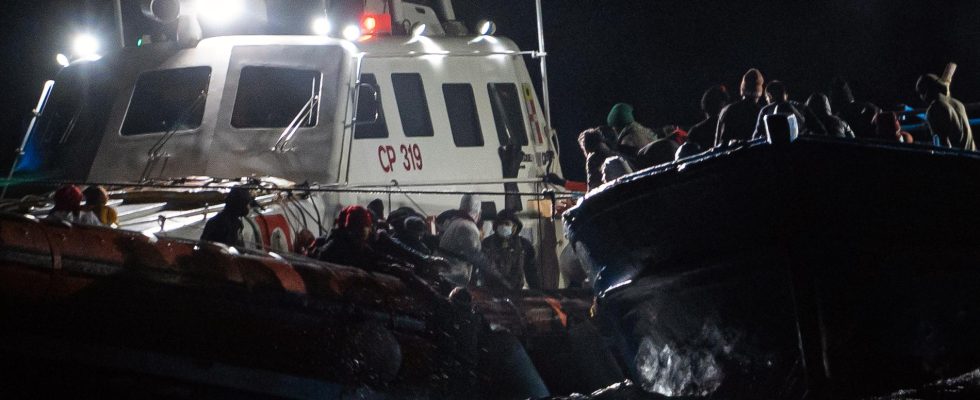Published: Less than 1 hour ago
full screen
Next
Migrants on their way to Italy are rescued after getting into distress off the southern island of Lampedusa. Archive image.
1 of 2Photo: Pau de la Calle/AP/TT
In the first two months of the year, nearly 12,000 illegal border crossings were made in the central Mediterranean, a deadly dangerous migrant route.
This is a doubling compared to the corresponding period last year, according to the EU’s border police Frontex.
The migrant route in the central Mediterranean – the area between Italy, Sardinia and Tunisia – was the most used into the EU during the first two months of the year, notes Frontex.
During January and February, the EU border was crossed illegally 11,951 times there, an increase of 118 percent compared to last year.
Caroline Willemen, deputy head of the Doctors Without Borders rescue team in Italy, is not surprised by the high numbers. She spent most of last year aboard the organization’s rescue boat off the southern Italian coast.
– We meet people who have made this journey four, five, six times but have been sent back to Libya. Then they try again because the circumstances they live in there are impossible, says Caroline Willemen to TT.
Frontex thus reports that people have illegally entered the EU via the central Mediterranean route 11,951 times. But in several cases it may be about people who entered several times after being sent back.
“Would rather have died”
The route is by far one of the most dangerous, which the migrants are well aware of, according to Willemen. But for many, the alternatives – persecution, abuse and extreme poverty – are perceived as even worse.
– Some say they would rather die at sea than go back. So it’s not that they don’t know the risks, but that they simply don’t see any other way out.
During February, 7,000 illegal border crossings were recorded in the area, which is three times more than a year ago. Most of those detected trying to cross the border came from Syria, Ivory Coast, Afghanistan and Pakistan.
At the same time, the number of illegal border crossings on the western Mediterranean route, between Spain and Morocco, decreased by 38 percent.
An even greater reduction in illegal crossings occurred on the West Africa route between Morocco and the Canary Islands: 68 percent.
Second largest route
According to Caroline Willemen, basically all routes into Europe have become more dangerous over the years. Therefore, she does not think it is strange that the dangerous route across the central Mediterranean has seemingly become a more common option. She also mentions that some want to avoid ending up in certain countries, such as Greece.
– There we have seen that relatively many go directly to Italy from Turkey. You may think that sounds strange because the journey will be both longer and potentially more dangerous. But we also know that the conditions for migrants on the Greek islands are a reasonable reason for not wanting to end up there, says Willemen.
On the Western Balkan route, crossings decreased by 28 percent due to Serbia’s adaptation to EU visa rules, Frontex writes. However, the route remains the second largest for migrants trying to enter Europe.
In total, national authorities reported 28,130 illegal border crossings in the first two months of the year 2023. This is roughly the same number as the same period last year.
Makes work more difficult
With spring now approaching, the number of people seeking Europe via unreliable and downright dangerous roads and waterways will increase as the weather conditions improve. At the same time, it has become more difficult for Doctors Without Borders and other aid organizations to operate in Italy as a result of a new law that severely limits the possibilities of rescuing those in distress at sea.
Willemen says the law change has made their work significantly more difficult on several levels. But from a larger perspective, there is another issue that is more urgent, she believes.
– Trying to prevent people from moving to other places does not work. And if we want them to avoid dangerous paths, we must first make sure to create safe paths.
Facts
Deadly route across the Mediterranean
The EU’s border police Frontex provides statistics on three different migrant routes across the Mediterranean: the western, the central and the eastern.
The route across the central Mediterranean has been called one of the world’s deadliest migrant routes. How many migrants have taken it over the years has varied, depending on, among other things, Libya’s refugee policy. Now the pressure on the route is increasing again.
According to a report by Save the Children earlier in February, over 8,400 migrants on their way to Europe have drowned in the Mediterranean over the past four years.
The organization states that around half a million people on the run since 2019 have attempted to cross the Mediterranean. In a report from the UN migration agency IOM from October 2022, however, it is stated that the death toll is probably clearly higher than those reported.
Italy, where many migrants crossing the Mediterranean end up, recently passed laws that, among other things, make it illegal for aid organizations to pick up castaways from more than one boat at a time.
Read more
